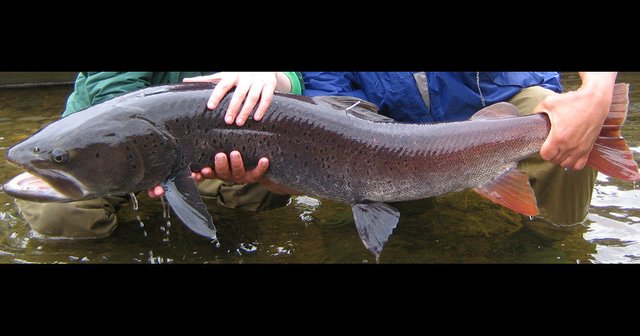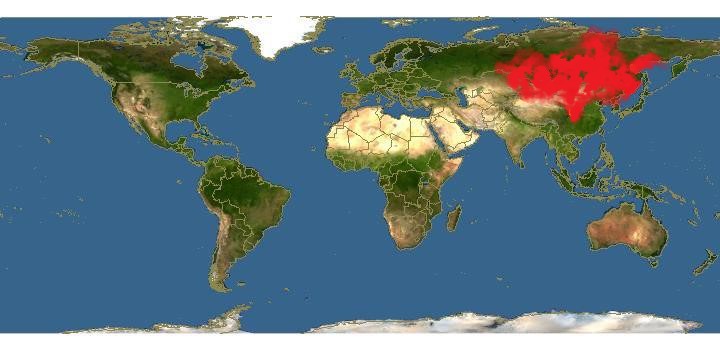The Siberian Giant Trout is dynamic and strong predator which feeds on fishes but in some cases rodents and birds. Popular fishing target because of its perseverance, power and great meat quality/taste which was a reason of substantial population reduction. There are often illegal commercial harvests. Hopefully there are people, "Taimen Conservation Fund", which are working on conserving the remaining populations. It's not easy task because Taimen is slow growth and reproduction species of fish.
Before you will see the video a short information about this fish.
The Taimen, Siberian Giant Trout or Siberian Salmon (Latin: Hucho taimen, Pallas, 1773)

Classification
Kingdom: Animalia
Phylum: Chordata
Class: Actinopterygii (ray-finned fishes)
Order: Salmoniformes (Salmons)
Family: Salmonidae (Salmonids)
Genus: Hucho
Species: H. taimen
Distribution
Europe and Asia: some upper tributaries of Pechora and Kama (with tributaries Vyatka, Belaya, Vishera, Chusovaya) in Volga drainage; Siberia from Ob' to Yana drainages; Amur and some adjacent drainages. Prior to the impoundment of Kama, used to enter Volga and to reach downriver to Samara. 
Size / Weight
Max length: 200 cm;
max. published weight: 105.0 kg (231.0 lb);
max. reported age: 55 years;
Environment
Freshwater; brackish;
benthopelagic; potamodromous;
cold waters; rivers and occasionally lakes;
Short description
Small cross-shaped dark spots on head and sides of body. Distinguished from other species of Salmonidae in central and eastern Europe by the combination of the following characters: teeth on vomer and palatine in a continuous, horse-shoe-shaped band; 173-288 scales in midlateral row (107-164 pored scales); small round dark spots on head and dark x-shaped or/and half-moon-shaped spots on body; head long and dorsally flattened; very long jaws in adults, maxilla reaching posterior margin of eye; shallow cylindrical body; caudal deeply emarginate, reddish in adults; large size in undisturbed areas; and 9-18 gill rakers, usually 11-13.
Biology
Adults inhabit piedmont and montane cold rivers with high oxygen concentrations. They prefer to live in deeper holes with slow current for periods of reduced activity (day time, winter), but also lower reaches, estuaries, cold lakes and reservoirs. Both juveniles and adults are territorial. Adults frequently occur within their own restricted territory (deep holes below rapids and waterfalls, confluence of small tributaries, below bridge pillar or large rocks, bank excavations), which they abandon only foraging and spawning. Young individuals do not maintain permanent territory. Juveniles occur in fast-flowing waters, prey on drifting invertebrates and shift to fish diet after 1-3 years. Adults feed on fishes and terrestrial vertebrates. They breed in shallow places with fast current on pebble bottom, immediately downstream of large deep pools, often in small river tributaries. Usually undertake upriver migration for spawning in the upper reaches of tributaries. Can overcome quite high obstacles while migrating to spawning sites. Eggs, 5-6 mm in diameter, hatch after 28-38 days. Alevins stay in gravel until yolk sac is absorbed after 10-15 days while young first remain near spawning site, then move downstream. Larger immature individuals of 2-4 years of age live in same sites as adults but separately below groups of adults or in smaller holes. Life span reaches up to about 20 years. Threatened due to habitat loss, pollution and over harvesting, including angling tourism.
Supporting source: http://www.fishbase.org
Video
STEEManians I want to especially thank for supporting:
@gregbit @margaretwise @glitterfart @hilarski @anahilarski @thearcanebear @mynameisbrian @jga @choogirl @linzy13 @cecirod1218@bibek @codypanama @donofa @fishdad
Here you can find some of my other posts/stories:
https://steemit.com/fishfacts/@edekadam/fish-facts-14-jeremy-wade-feat-giant-barracuda-video
https://steemit.com/fishfacts/@edekadam/fish-facts-13-jeremy-wade-feat-the-king-salmon-video
https://steemit.com/fishfacts/@edekadam/fish-facts-12-jeremy-wade-feat-the-white-sturgeon-video
Thanks for checking my posts if you like it vote and leave follow :)

Hi! I am a robot. I just upvoted you! I found similar content that readers might be interested in:
http://www.fishbase.org/summary/SpeciesSummary.php?id=8681
Downvoting a post can decrease pending rewards and make it less visible. Common reasons:
Submit